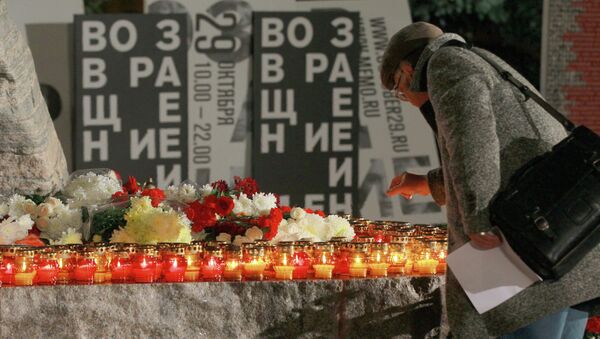MOSCOW, October 30 (RIA Novosti) — On October 30, Russia marks the Day of Remembrance for Victims of Political Repression. The date was chosen in memory of the hunger strike that inmates of the Mordovia and Perm labor camps began on October 30, 1974 in protest of political persecution in the USSR.
Officially, the day was passed under the October 18, 1991 Resolution of the RSFSR (Russian Soviet Federated Socialist Republic) Supreme Soviet on the Establishment of Remembrance Day for Victims of Political Repressions.
Under the Law on the Exoneration of Victims of Political Repressions, political repressions are defined as measures of coercion used by the state for political goals in the form of the deprivation of life or freedom, placement into psychiatric institutions for involuntary treatment, expulsion from the country and deprivation of citizenship, the deportation of groups of people from their places of residence, internal exile and banishment to special settlements, forced labor in custody and other deprivation or limitation of rights and freedoms.
On the Remembrance Day, tribute is paid to the millions of people who were unjustly subjected to reprisals, sent to correctional labor camps and into exile, and who were executed during and after Stalin"s Great Terror.
The peak of repression came in 1937-38, when, according to official records, over 1.5 million people were arrested on political charges, 1.3 million were convicted by extrajudicial bodies and about 700,000 were executed by firing squads. The "enemy of the people" concept became part of daily life for citizens of the Soviet Union. Under the Politburo"s July 5, 1937 resolution, wives of "enemies of the people" were to be imprisoned for terms of no less than five to eight years. The children of "enemies of the people" were either sent to the NKVD [the People"s Commissariat for Internal Affairs, a forerunner to the KGB] camps or were placed in special orphanages.
During Stalin"s rule, 3.5 million people were subjected to reprisals on ethnic grounds. Forty-five percent of command personnel were purged from the Army, while during and after World War II, Soviet citizens who had become prisoners of war and were sent to forced labor in Germany were subjected to harsh repression.
The total number of persons subjected to reprisals on an administrative, not judicial (or quasi-judicial), basis reached 6.5 million to 7 million.
The principal target of the regime"s repressive policy from the 1960s to the 1980s was dissent. Between 1967 and 1971, KGB bodies "exposed" over 3,000 "political harmful" groups. The exoneration of the victims of political repression in the USSR started in 1954. In the mid-1960s, the campaign was put on hold and only resumed in the late 1980s.
On October 18, 1991, the RSFSR Law on the Exoneration of Victims of Political Repression was adopted.
The law was designed to exonerate all victims exposed to political repression in the RSFSR from November 7, (October 26, Old Style) 1917, reinstate their civil rights, eliminate other consequences of arbitrariness and provide adequate compensation for financial and moral damage.
In 1992, a presidential commission on the exoneration of the victims of political repression was established.
On March 14, 1996, the presidential executive order, Measures to Exonerate Members of the Clergy and Believers Who Became Victims of Unwarranted Repression, was signed.
On October 30, 1990s, the Solovetsky Stone, which had been brought to Moscow upon the initiative of the Memorial society of the Solovki Islands, where a special purpose camp was located in the 1920s –the first in the system of Stalinist labor camps – was unveiled on Moscow"s Lubyanka Square.
Every year, on the eve of Remembrance Day, activists from the Memorial human rights center hold an event called Names Returned, during the course of which the names of the victims of political reprisals are read out.
In 2012, hundreds of people also gathered to pay tribute to those executed at the Butovo shooting range just outside Moscow, where victims of Stalinist repression were executed on a mass scale. It was the first time such an event was held at Butovo. Memorial events were also held in Tula, Norilsk and other cities in Russia.
In Komsomolsk-on-Amur, a monument to victims of political reprisals was unveiled, while the Moscow Gulag History Museum posted on a special website the names of almost 10,000 people executed in Moscow in 1937 and 1938. In St. Petersburg, the Solovetsky Stone was installed on Troitskaya Square in 2002. Every year on Remembrance Day, relatives of victims hold a rally near the Solovetsky Stone. In 2013, about 300 people took part in the event. At the Levashovo Memorial Cemetery, where at least 45,000 people executed during the years of repression were buried, a memorial ceremony was held with the laying of wreathes and flowers and a requiem service was conducted. The names of victims of political repression in Leningrad were read out throughout the day at the Russian Political History Museum and in the garden outside the Anna Akhmatova Memorial Museum.
On October 30, 2013, a chapel in memory of the victims of political reprisals was unveiled at Vladivostok"s Lesnoye Cemetery, where a memorial in honor of the victims of repression in the Primorye Territory is located.




